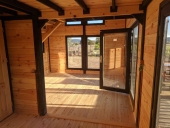Hi There,
I would assume that in a post and beam foundation, the beams should sit on top of the posts for better load bearing ability. But in some builds, I see that beams are nailed to the posts. Here is a youtube link
to a builder who I am sure knows his stuff, but he is nailing (see the part between 2:30 and 3:00). Is it because the total weight the beams will carry is not that much so that nailing works? If you were to build one from scratch, would you recommend the beams to sit on the posts rather than being nailed to them. I can see one advantage of nailing the beams, which is that they get tightly attached to the posts. If we were to put the beams on the posts, we can still do it but may require some L-shaped braces or diagonal screws.
Thanks for any insight.








